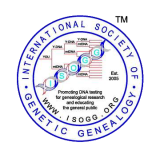Fully identical region
From ISOGG Wiki
Incorrect numbers?
In paragraph 3, suggest the following changes:
"The expected percentages for full siblings are 25%50%half-identical, 12.5%25%completely identical, and 50%25%not identical for an overall matchingaverageof 50%."
The 50 and 25 make sense only if you are talking about the percent amount matched in half-match tools. 25 and 12.5 is the actual percent match of the chromosomes. The 25% not-identical only applies to the perceived result of the half-match tools when looking at the result; not what the tools actually report. Actual DNA not identical will be 50% on average; based on the simplified, algebraic analysis of this page.. So these three numbers in the original text cannot be explained. Note that with these new numbers, the "expected" report from half-match tools is easily given, seen and derived by simply adding the two match numbers shown to get to the 37.5% for full siblings as reported on the page.
A corresponding change in the Autosomal DNA Statistics page should be made as well. (The confusion of Method 1 and Method 2 aside).
--SurplusGadgets (talk) 17:02, 1 June 2017 (EDT)
Dear Randy, The FIR data at https://isogg.org/wiki/Fully_identical_region is correct as written. I presume that you agree that full siblings share 50% of their autosomal DNA on average. If you agree with this then the other data makes perfect sense. This is how it works:
50% half-identical: 25% of all autosomal DNA 25% fully-identical: 25% of all autosomal DNA 25% of regions with no shared DNA at all: 25% of all autosomal DNA Opposite strand of the 50% half-identical: 25% of all autosomal DNA
The only thing I think that could be improved is how this sentence reads: “The expected percentages for full siblings are 50% half-identical, 25% completely identical, and 25% not identical for an overall average of 50%.” Perhaps this would be a better choice of words: “The expected percentages for full siblings are 50% half-identical, 25% completely identical, and 25% of regions with no shared autosomal DNA for an overall average of 50%.”
If you all are ok with that then I will update that sentence on the wiki. Tim Janzen Portland, OR
